Anthurium magnificum was the first anthurium plant I acquired, and it is the one that started my love for anthuriums and aroids in general. This blog covers everything I wish I had known when I first started growing anthuriums indoors.
We’ll go over Anthurium magnificum care, and the differences between similar-looking anthurium species, and for fun, we’ll rank some cool anthurium hybrids. So read till the end to see some magnificent plants!

According to Dr. Thomas B Croat, a known aroid botanist and the world’s leading authority on the genus Anthurium, more than 1500 species of Anthurium are known, and more species are discovered every year. Anthurium magnificum is just one of them!
Family: Araceae
Genus: Anthurium
Species: Magnificum
Section: Cardiolonchium
About Anthurium Magnificum
Anthurium magnificum is a tropical plant native to Colombia’s regions of Risaralda and Cundinamarca. It is a terrestrial anthurium that grows at intermediate elevations on the western slopes of the Andes Mountains at an altitude of 800-2125 meters.

The emerging leaves are deep burgundy that transitions to orange and light green before maturing to deep dark green.
Anthurium Magnificum leaves steal the show
Anthurium magnificum dark green leaves steal the show and are why anthuriums are my favorite genus of aroids and tropical plants in general.
The leaves are velvety to the touch. They have prominent basal lobes and white or silver veins that sparkle in the light.


The shape of the leaves is cordate, or heart-shaped, but less so than that of Anthurium clarinervium. The leaves can grow to a very large size.
Did you know that species are widely variable and can produce leaves with different characteristics and forms among plants of the same species?
Stadium of Anthurium Magnificum leaves expanding
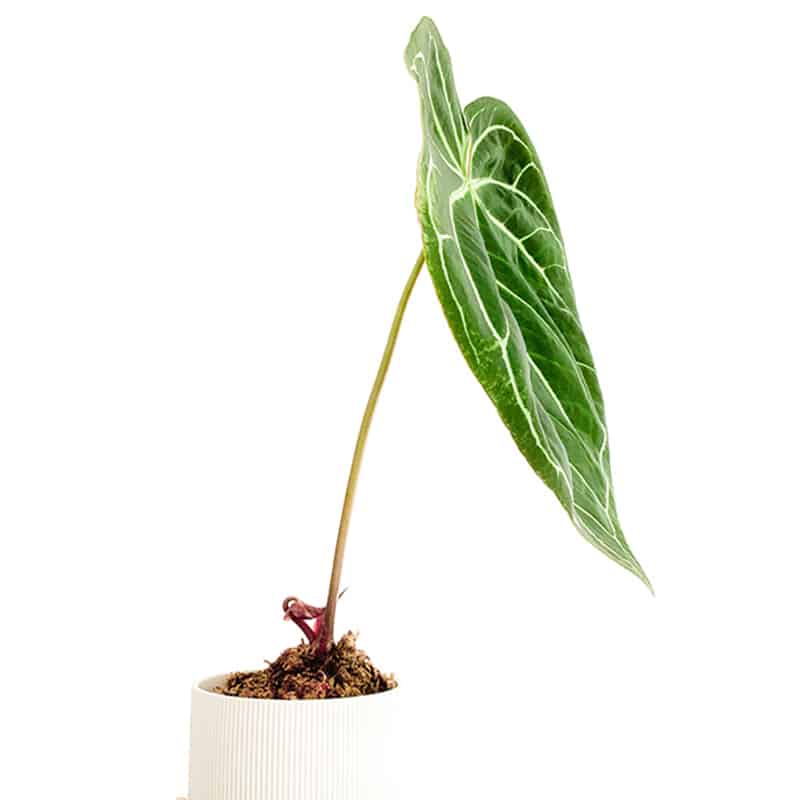

While the sheer size of mature leaves will make you gasp, I find them truly fascinating when they first unfurl. Unlike other plants that unfurl full-size leaves, anthurium leaves start very tiny and expand over time to reach maximum size in a couple of weeks.

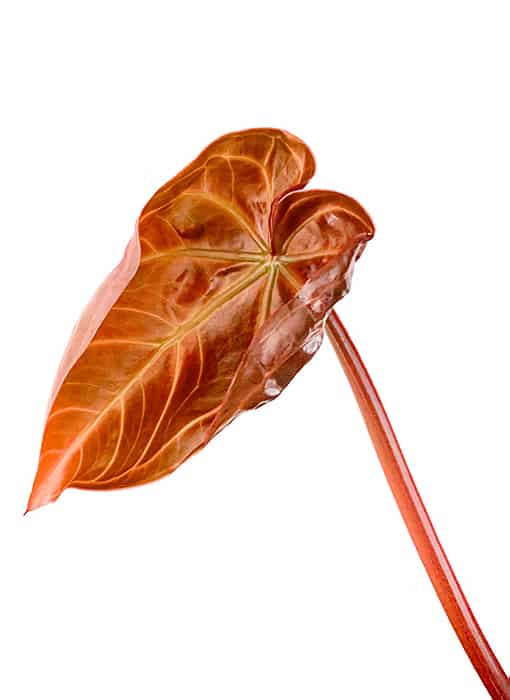
The emerging leaves are deep burgundy that transitions to orange and light green before maturing to deep dark green. The new leaves are also very ‘floppy’ and harden off after a while.


I recommend resisting the temptation to touch the leaves while they’re expanding, as they’re fragile. Sometimes leaves get stuck while trying to emerge from the leaf petiole base, especially in lower-humidity environments. I strongly advise misting the emerging leaf rather than trying to help it.

This is the result: the tip of the leaf got ripped in the process while I tried to ‘help’ it.
Anthurium Magnificum petioles: how to tell which anthurium species you have
Anthurium magnificum petioles are squarish or tetrahedral and narrow-winged, which is the most straightforward way to tell them apart from other species, such as Anthurium crystallinum or Anthurium clarinervium, which have primarily round petioles.
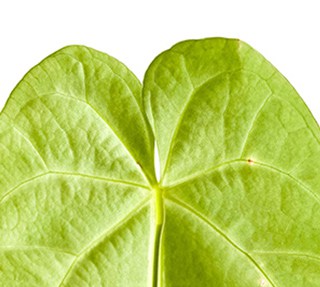

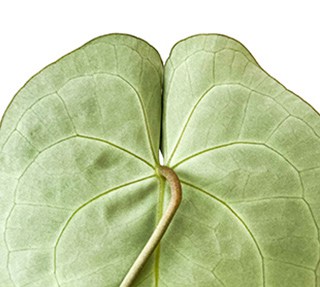
Anthurium Magnificum inflorescence
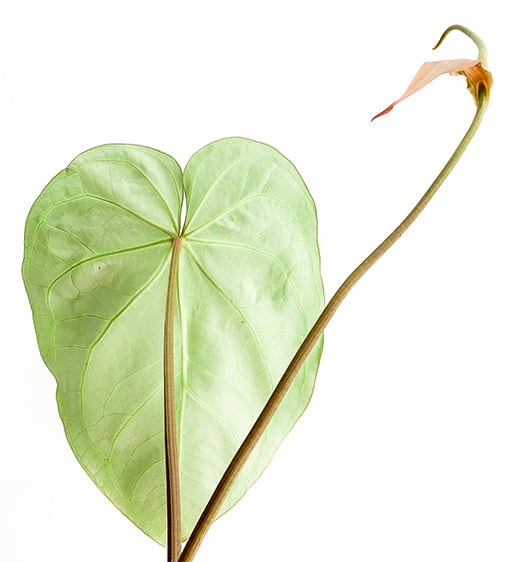
While the ‘flower,’ or rather an inflorescence, is not spectacular by any means, it is key to pollinating and propagating anthuriums.
Anthuriums have perfect flowers, which means that they produce both male and female flowers on one inflorescence.

New inflorescence will come out of an existing leaf petiole. This is the easiest way to tell whether you have a new inflorescence coming out or another leaf.
It may take many weeks or months from the pollination to the successful harvest of the berries.
Anthurium Magnificum vs Crystallinum
If you’re new to the houseplant hobby, you might wonder what the difference is between Anthurium magnificum and crystallinum. I know I did at the beginning.
An easy way to differentiate magnificum from crystallinum is by comparing the petioles. A. magnificum has quadrangular/square types of petioles, and crystallinum has them round.


Also, the leaves on Anthurium magnificum are much larger than on anthurium crystallinum, and the venation is very different among the two species.
Anthurium Magnificum vs Clarinervium
Anthurium magnificum is sometimes confused with Anthurium clarinervium, but the latter has smaller leaves with more rounded, better-defined heart shapes.


Anthurium clarinervium also has better-defined veins. Clarinervium also has much darker leaves than magnificum.
Anthurium Magnificum vs Regale
The easiest way to tell magnificum from regale is by looking at the venation. The veins on the Anthurium regale are much more defined and intricate, closer to the leaf border.


Anthurium Magnificum Verde vs Norte
I should preface this paragraph with a statement that there isn’t any definite answer on the internet about Anthurium magnificum ‘Verde’ and Anthurium magnificum ‘Norte’.
Some say Anthurium magnificum verde is a separate species.
Others say it is an ecotype, in other words, the same species that looks different because it grows in different geographical conditions.
Some others yet say magnificum verde is a hybrid of magnificum and regale.


Verde just means ‘green’, and as you can see in the photos, the leaves are different than those of Anthurium magnificum. The veins on anthurium magnificum verde as less silvery and less pronounced. The leaf appears “greener,” and its shape is more elongated. I see it as a ‘plainer’ version of Anthurium magnificum but still quite enjoyable.
There is even less information about Anthurium magnificum norte. The opinion that circulates the most frequently is that it is an ecotype.
Apparently, Anthurium magnificum norte has five sides on the petiole, unlike regular magnificum, which has four.
Researching magnificum norte and verde was one of the most frustrating tasks I’ve done for this blog. If there is an expert out there that can clarify the difference between anthurium magnificum verde, norte, and regular magnificum, please message me on Instagram, and I’ll update this blog for everyone.
Anthurium Magnificum Care Guide
Anthurium magnificum was once a very popular houseplant in the nineteenth century, and like many aroids these days, it is once again one of the favorite anthuriums to grow indoors.
Anthurium magnificum care indoors is similar to other anthuriums or aroids in general. It requires bright indirect light but no direct sunlight, a well-draining soil mix, warm temperatures, high humidity, and good air circulation as it’s a tropical rainforest plant. Knowing where the plant came from always provides clues to its growing needs. Here are some of my top tips on how to care for Anthurium magnificum indoors.
Light
Anthurium magnificum requires bright, indirect light. As it naturally grows in the tropical rainforest, it receives dappled light.
I have grown Anthurium magnificum in places in my apartment that receive very little natural light, and while they have grown, the growth was somewhat stunted. The fastest growers are the ones that receive the most light.
In my experience, getting the light requirements right and the appropriate potting mix to your environmental conditions are the most critical factors to successfully growing anthurium indoors.
Producing large leaves takes a lot of energy, so the more light you can provide, the bigger the leaves you will get. But direct sunlight will scorch the leaves, so avoid too strong light exposure.

Soil / Potting Mix
Anthurium magnificum soil requirements are somewhat tricky to master, especially for novice growers. It needs a chunky mix that drains quickly and provides a lot of aeration for the roots.
My mix includes orchid bark, coco coir, perlite, coco chips, warm castings for an extra nutrient boost, and sometimes leca for additional aeration.
I use a soil-less potting medium as potting soil stays wet for too long, and the roots will suffocate. Getting the potting mix right is the best way to prevent root rot.
Water
In nature, Anthurium magnificum gets frequent rain showers, but the water never stays standing. Anthuriums, like most aroids, like to be moist but never consistently wet.
It will rot if it is too wet a medium, but the roots don’t like to dry out. Adding sphagnum moss as top-dressing on potting media is excellent for retaining moisture and encourages new root growth from the base of the plant.
While I water all my plants with tap water, I let it sit for at least 24 hours to allow any trace chemicals to evaporate. As my potting medium is very porous, water flushes through it very fast, and I make sure I water thoroughly.
Once you create a well-draining potting mix, you can stop worrying about overwatering.
Temperature
As a tropical plant, Anthurium magnificum enjoys warm temperatures and high humidity. It will thrive in temperatures ranging anywhere from 64F to 86F (18C to 30C).
The temperature in my apartment is at around 75F all year round. And I grow them outside of IKEA cabinets or grow tents.
Humidity
Anthurium magnificum thrives in high humidity and prefers 70-80% at all times. In their natural environment, humidity is often near 100%.
While most homes will have much lower humidity, especially in winter when the heating is on, supplementing it with a humidifier could help.
As I live in a tropical zone, my indoor humidity oscillates between 50-60%. My anthuriums don’t seem to mind, though.
Plants can adapt to an environment to a certain degree. I prefer to get plants as seedlings because I find them easier to acclimate to my specific conditions.
While humidity is important, in my experience, it is not a critical factor in growing anthurium magnificum indoors.
Fertilizer
As my potting medium is soilless, I make sure that my anthuriums get enough nutrients. I use diluted liquid fertilizer at every watering.
Either fish emulsion or seaweed fertilizer works well. I also add worm castings to the potting mix for an additional nutrient boost. Many fertilizer options are available on the market, so you should experiment with what works best for you.
Propagation
If you’re interested in knowing how to propagate anthuriums, I have a couple of guides. Check out my Anthurium gracile blog for propagation from seeds, and Anthurium forgetii for propagation through stem cuttings.
Top Anthurium Magnificum hybrids

Anthuriums are frequently hybridized by nurseries and collectors alike because of their magnificent foliage and popularity as houseplants.
Anthurium magnificum is often hybridized with other anthurium species to produce plants that exhibit both characteristics of parent plants. But this often leads to mislabeling and misidentification of the plants.
Often unscrupulous sellers will invent the cross simply by looking at which plant is in most demand (read the most expensive) and sell it as a rare hybrid.
It is very difficult to identify parentage correctly just by looking at the plant unless you know the provenance. Given the natural variability among plants of the same species, knowing what hybrid you have is sometimes nearly impossible.
With that in mind, let’s look at some of the most popular and rank the coolest Anthurium magnificum hybrids.
1. Anthurium Magnificum x Papillilaminum


Anthurium magnificum x papillilaminum hybrid tops the Plant Girl Boss’ ranking of top magnificum crosses.
It has the distinct lobes of an Anthurium papillilaminum and the roundness of magnificum. A hardy cross that will be a stunning addition to your Araceae plant family collection.
2. Anthurium Magnificum x Moronense

The runner-up in the PGB’s ranking is the Anthurium magnificum x moronense hybrid. The unusual leaf shape takes after Anthurium moronense, which sports three-lobed leaves.
The image is still of a juvenile plant, and the leaves will look quite different when the plant matures. It doesn’t have the velvety texture of magnificum, but it will make your collection more interesting nevertheless.
3. Anthurium Magnificum x Luxurians

Anthurium luxurians produces one of the most stunning hybrids, and this Anthurium magnificum x luxurians cross is not an exception. The heart-shaped leaves of magnificum combined with the pebbled-like texture of Anthurium luxurians are perfection.
4. Anthurium Magnificum x Dressleri

Dark & velvety – what else could you ask for in a hybrid? The magnificum x dressleri hybrid definitely delivers! Squarish petioles are a telltale of magnificum, and the reddish shimmery tint on the pillowy leaves is a dressleri trait.
5. Anthurium Magnificum x Regale
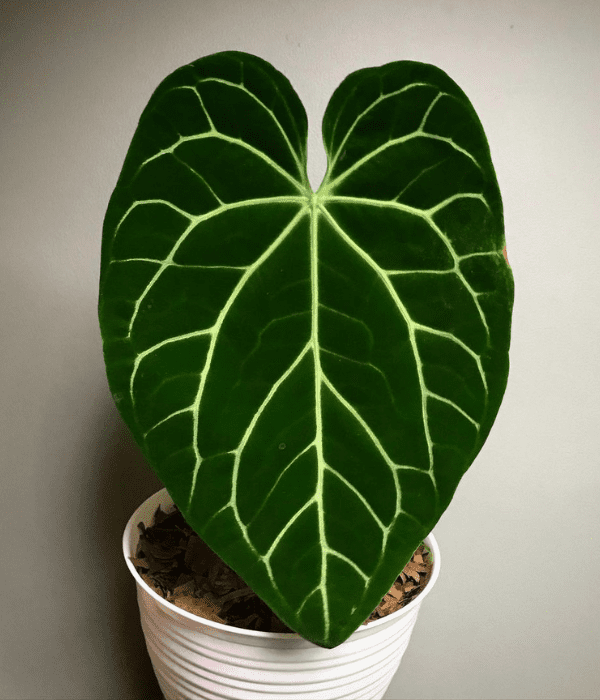
In Indonesia, the magnificum x regale hybrid is called Anthurium Petir, which means lighting. It sure looks striking!
6. Anthurium Magnificum x Forgetii

If you’re looking for a smaller hybrid, Anthurium magnificum x forgetii has you covered. See the reverse cross (Anthurium forgetii x magnificum) on my Anthurium forgetii blog.
7. Anthurium Magnificum x Crystallinum


Anthurium magnificum x crystallinum, is often labeled as Anthurium magnificum silver. The square and winged petioles suggest predominant magnificum parentage, and the elongated leaves with strong silver veining indicate the presence of Anthurium crystallinum.
Anthurium magnificum silver is not a different species but a made-up name by growers as a marketing tactic. The magnificum x crystallinum hybrid is one of the easier crosses to acquire, given the popularity and availability of the parent species.
Growing Anthurium magnificum indoors doesn’t have to be a daunting task. With the tips for growing Anthurium magnificum indoors I’ve provided, I believe anyone can grow this stunning aroid successfully.
Remember, it’s all about the right balance – from watering and temperature, to lighting and soil composition. I hope you’ll give this magnificent tropical plant a shot. Trust me, the stunning beauty it’ll bring to your space is worth every bit of effort!

